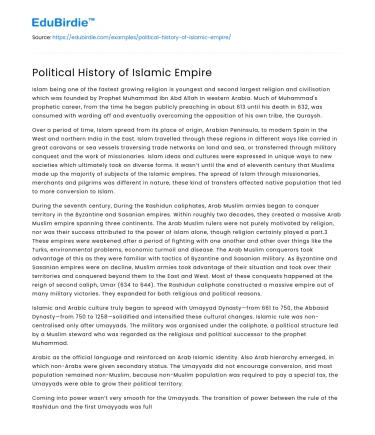Islam being one of the fastest growing religion is youngest and second largest religion and civilisation which was founded by Prophet Muhammad ibn Abd Allah in western Arabia. Much of Muhammad's prophetic career, from the time he began publicly preaching in about 613 until his death in 632, was consumed with warding off and eventually overcoming the opposition of his own tribe, the Quraysh.
Over a period of time, Islam spread from its place of origin, Arabian Peninsula, to modern Spain in the West and northern India in the East. Islam travelled through these regions in different ways like carried in great caravans or sea vessels traversing trade networks on land and sea, or transferred through military conquest and the work of missionaries. Islam ideas and cultures were expressed in unique ways to new societies which ultimately took on diverse forms. It wasn’t until the end of eleventh century that Muslims made up the majority of subjects of the Islamic empires. The spread of Islam through missionaries, merchants and pilgrims was different in nature, these kind of transfers affected native population that led to more conversion to Islam.
Save your time!
We can take care of your essay
- Proper editing and formatting
- Free revision, title page, and bibliography
- Flexible prices and money-back guarantee
During the seventh century, During the Rashidun caliphates, Arab Muslim armies began to conquer territory in the Byzantine and Sasanian empires. Within roughly two decades, they created a massive Arab Muslim empire spanning three continents. The Arab Muslim rulers were not purely motivated by religion, nor was their success attributed to the power of Islam alone, though religion certainly played a part.3 These empires were weakened after a period of fighting with one another and other over things like the Turks, environmental problems, economic turmoil and disease. The Arab Muslim conquerors took advantage of this as they were familiar with tactics of Byzantine and Sasanian military. As Byzantine and Sasanian empires were on decline, Muslim armies took advantage of their situation and took over their territories and conquered beyond them to the East and West. Most of these conquests happened at the reign of second caliph, Umar (634 to 644). The Rashidun caliphate constructed a massive empire out of many military victories. They expanded for both religious and political reasons.
Islamic and Arabic culture truly began to spread with Umayyad Dynasty—from 661 to 750, the Abbasid Dynasty—from 750 to 1258—solidified and intensified these cultural changes. Islamic rule was non-centralised only after Umayyads. The military was organised under the caliphate, a political structure led by a Muslim steward who was regarded as the religious and political successor to the prophet Muhammad.
Arabic as the official language and reinforced an Arab Islamic identity. Also Arab hierarchy emerged, in which non-Arabs were given secondary status. The Umayyads did not encourage conversion, and most population remained non-Muslim, because non-Muslim population was required to pay a special tax, the Umayyads were able to grow their political territory.
Coming into power wasn’t very smooth for the Umayyads. The transition of power between the rule of the Rashidun and the first Umayyads was full of strife. Debates took place about the nature of Islamic leadership and religious authority. These conflicts evolved into major division between Sunni, Shia, and Ibadi Islam.
Ultimately, there were many times that regarded the Umayyads as illegitimate and corrupt, some of whom rallied around with new leaders. These new leaders claimed legitimacy through shared blood with the prophet Muhammad, through the prophet’s uncle, Abbas. They led a revolt against the Umayyads, bringing the Abbasid caliphate to power. It was widely accepted in the early community of Believers that Muhammad could have no successor in his role as Prophet. But the early Believers decided that someone should succeed Muhammad as temporal head of the community. The first documentary references call the leader of the community of Believers not caliph but amir al-mu minin ('commander o f the Believers'), and this may be the original term for the heads o f the community, replaced only some time later by the term caliph, which was seen as synonymous but had the advantage of being found in the Quran.
The Abbasids were fixed on differentiating themselves from the Umayyad dynasty, but they still had a lot in common. They were both dynastic and centralised. However, the Abbasid dynasty changed the social hierarchy by constructing a more inclusive government in a more cosmopolitan capital.
Under the Abbasids, Islamic art and culture flourished. They are famous for inaugurating the Islamic golden age. Religious scholars, called ulema, developed more defined religious institutions and took on judicial duties and developed systems of law. It was also during Abbasid rule that many people converted to Islam, for a multitude of reasons including sincere belief and avoiding paying taxes levied on non-Muslims. As a result, Islamic culture spread over the Abbasids’ vast territory.5 Islamic law originates in two major sources: divine revelation (wahy) and human reason (aql). This dual identity of Islamic law is reflected in its two Arabic designations, Shariah and fiqh. Shariah bears a stronger affinity with revelation, whereas fiqh is mainly the product of human reason. Shariah literally means 'the right path' or 'guide,' whereas fiqh refers to human understanding and knowledge.






 Stuck on your essay?
Stuck on your essay?

